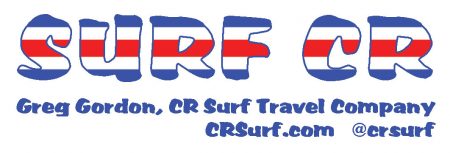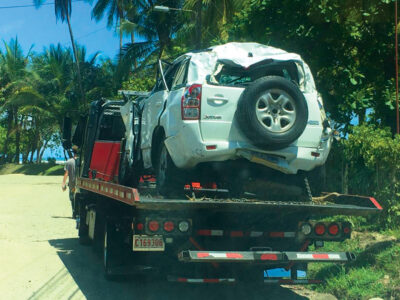Car Rentals in Costa Rica: Deciding on Insurance Options
 What does this have to do with surfing in Costa Rica? A lot, since when you are planning a vacation, it is one of the most important decisions to make. You have decided to rent a SUV with 4wd and now you have to decide which insurance option to take.
What does this have to do with surfing in Costa Rica? A lot, since when you are planning a vacation, it is one of the most important decisions to make. You have decided to rent a SUV with 4wd and now you have to decide which insurance option to take.
A. Full collision coverage with a $0 deductible and a very low deposit (usually $100).
B. Basic collision coverage with a $1000 deductible and a higher deposit (usually $500-1000).
 C. Use the collision coverage on your credit card and just get the minimum insurance required, called third party liability, which covers the other person’s vehicle and injuries and has a $5000 deductible. Your deposit is the highest (from $500 to $2000+).
C. Use the collision coverage on your credit card and just get the minimum insurance required, called third party liability, which covers the other person’s vehicle and injuries and has a $5000 deductible. Your deposit is the highest (from $500 to $2000+).
Option A costs the most and option C the least. The actual costs vary with each car rental company, but for this article I will choose Alamo for my explanation. Their rates when I book the reservation for you are $30/day for option A, $15/day for option B, and $10/day for option C for midsize and standard SUVs. The larger Fortuners, Prados, and vans are $40/day for option A and $25/day for option B.
To determine which is best, it depends on your tolerance to risk and your budget. Driving in the city a lot or well off the paved roads in the countryside would have more risk for damages. If you are driving in the peak of rainy season, late September to early November, then the chance of muddy roads, bigger pot holes, and flooding are possible. One way to determine your risk is to confirm with your Airbnb hosts exactly what the road conditions are leading to their house. And even though the weather forecast is going to show rain every day on your trip, be sure to check that there is not a tropical storm or hurricane that will cause heavy rain fall.
Most clients tell me they want option C, the cheapest, since their credit card has collision coverage. I send them the terms of the rental company which clearly state – “if the renter provides acceptable proof of current coverage in Costa Rica and declines both CDW-TP and APP (collision coverage), the renter is responsible for the full value of damage to or loss of the vehicle.” That could mean if your bumper is dented, it may cost $1400 to fix and you have to pay the rental company first and then file a claim with your credit card company to get the money back. The credit card company does not pay the rental company directly. You have to pay. You have TRAVEL insurance, not CAR insurance. In a worst-case scenario, flooding damages the whole interior of the vehicle and causes the computer systems in a 2021 model to need to be replaced and you are charged $20,000. You would have to pay for all of it.
With option B, basic collision coverage, you would only be responsible for the first $1000 in damages. Then Alamo would cover the rest. There are exceptions, like if you did some illegal like drinking and driving, or driving recklessly, or if you crossed a river, which voids the rental agreement. You still have to pay up to $1000, but you have some peace of mind that if the vehicle was totaled you would not have to pay more.
Option A, full coverage with a $0 deductible, offers peace of mind. You do not have to pay anything as long as you were not doing something to void the terms of the agreement. A tree can fall on your car, you can be side swiped by another vehicle, you can slide off the road into a river, and you would be covered 99% of the time. Full coverage with Alamo also includes glass/tire coverage, for any rocks that nick the windshield or random tire punctures. In includes 24/7 free roadside assistance as well. The other options include roadside assistance, but you would have to pay for the tow truck.
For all three options, if the problem is mechanical and was not caused by the renter, Alamo would fix the problem or send a replacement vehicle for no charge. No company is perfect, but Alamo attempts to provide great customer service and keep newer vehicles in their inventory to reduce mechanical problems. Currently all their vehicles are 2020 or newer. That is one reason why I recommend them and Adobe, who also have a newer fleet and great customer service. Both have offices in Quepos which helps if you need assistance quickly.
However, no company is perfect, and sometimes it feels to the client that they are being overcharged for a minor repair. A broken rearview mirror could be $400, a broken tire rim could cost $800, and an air bag computer over $3000. That is when having me on your side is a benefit. Even though I partner with rental companies to get you the best price, I work on your behalf to ensure you are being treated fairly.
So, to answer which insurance is best? It really depends on your budget and your tolerance to risk. If you want to save money and are a careful driver with experience driving in Costa Rica and don’t think you will be on any unpaved roads, then take just the third-party liability insurance. Be sure to read your credit card’s policy for collision carefully so you know what to expect and what is covered and for how long. Some company’s max coverage is 30 days. If you want that peace of mind and can afford it, then take the full coverage. And if you want a balance of the two, take the basic collision coverage with the $1000 deductible.
I love driving around Costa Rica. Most of the roads are well paved and marked, the lower max speed limits remind me to slow down and appreciate the natural beauty of the country, and to respect the small communities that I drive through where many citizens still walk and bike around. And at times I enjoy driving to remote places like Matapalo on the Osa Peninsula or Pavones to surf, and those roads towards the end of the trip are not in good shape especially if it has been raining heavily. So when I go there I am certain to have extra insurance for my rental vehicle.
For more tips on renting a vehicle in Costa Rica, read this article: crsurf.com/travel-blog/11-tips-for-renting-a-car-in-costa-rica/.
